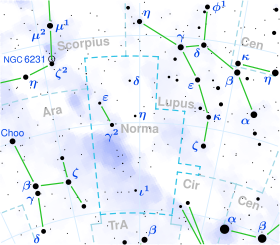| Observation data Epoch J2000 Equinox J2000 | |
|---|---|
| Constellation | Norma |
| Right ascension | 16h 18m 51.8325s[1] |
| Declination | −57° 53′ 59.244″[1] |
| Apparent magnitude (V) | 6.394[2] (6.12 - 6.77[3]) |
| Characteristics | |
| Spectral type | F8-G0Ib[3] + B9.5V[4] |
| U−B color index | +0.66[5] |
| B−V color index | +1.00[5] |
| Variable type | δ Cepheid[3] |
| Astrometry | |
| Radial velocity (Rv) | 5.83[6] km/s |
| Proper motion (μ) | RA: 0.07[1] mas/yr Dec.: 0.04[1] mas/yr |
| Parallax (π) | 1.16 ± 0.76 mas[1] |
| Distance | 924[2] pc |
| Absolute magnitude (MV) | -4.02[4] |
| Orbit[4] | |
| Period (P) | 8,660 yr |
| Semi-major axis (a) | 794 AU |
| Details[4] | |
| Mass | 6.3 M☉ |
| Radius | 65.6[2] R☉ |
| Luminosity | 3,630 L☉ |
| Temperature | 6,350 K |
| Metallicity | +0.10[7] |
| companion | |
| Mass | 2.4 M☉ |
| Age | 80[8] Myr |
| Other designations | |
| Database references | |
| SIMBAD | data |

S Normae (S Nor) is a yellow supergiant variable star in the constellation Norma. It is the brightest member of the open cluster NGC 6087.
S Normae is a Classical Cepheid variable with a visual magnitude range of 6.12 to 6.77 and a period of 9.75411 days. The spectral type varies during the pulsation cycle from F8 to G0. Its mass has been measured at 6.3 M☉ with reference to a close orbital companion, and it is over 3,000 times as luminous as the sun.
- ^ a b c d e Van Leeuwen, F. (2007). "Validation of the new Hipparcos reduction". Astronomy and Astrophysics. 474 (2): 653–664. arXiv:0708.1752. Bibcode:2007A&A...474..653V. doi:10.1051/0004-6361:20078357. S2CID 18759600.
- ^ a b c Moskalik, P.; Gorynya, N. A. (2005). "Mean Angular Diameters and Angular Diameter Amplitudes of Bright Cepheids". Acta Astronomica. 55: 247. arXiv:astro-ph/0507076. Bibcode:2005AcA....55..247M.
- ^ a b c Samus, N. N.; Durlevich, O. V.; et al. (2009). "VizieR Online Data Catalog: General Catalogue of Variable Stars (Samus+ 2007-2013)". VizieR On-line Data Catalog: B/GCVS. Originally Published in: 2009yCat....102025S. 1. Bibcode:2009yCat....102025S.
- ^ a b c d Cite error: The named reference
evans13was invoked but never defined (see the help page). - ^ a b Ducati, J. R. (2002). "VizieR Online Data Catalog: Catalogue of Stellar Photometry in Johnson's 11-color system". CDS/ADC Collection of Electronic Catalogues. 2237. Bibcode:2002yCat.2237....0D.
- ^ Mermilliod, J. C.; Mayor, M.; Udry, S. (2008). "Red giants in open clusters. XIV. Mean radial velocities for 1309 stars and 166 open clusters". Astronomy and Astrophysics. 485 (1): 303–314. Bibcode:2008A&A...485..303M. CiteSeerX 10.1.1.30.7545. doi:10.1051/0004-6361:200809664.
- ^ Klagyivik, P.; Szabados, L. (2009). "Observational studies of Cepheid amplitudes. I. Period-amplitude relationships for Galactic Cepheids and interrelation of amplitudes". Astronomy and Astrophysics. 504 (3): 959. arXiv:0908.3561. Bibcode:2009A&A...504..959K. doi:10.1051/0004-6361/200811464. S2CID 18283579.
- ^ Netopil, M.; Paunzen, E.; Heiter, U.; Soubiran, C. (2016). "On the metallicity of open clusters. III. Homogenised sample". Astronomy & Astrophysics. 585: A150. arXiv:1511.08884. Bibcode:2016A&A...585A.150N. doi:10.1051/0004-6361/201526370. S2CID 118382876.
